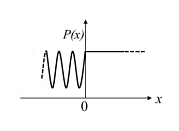A particle moving along the x-axis approaches 𝑥=0 from 𝑥 =−∞ with a total energy E. It is subjected to a potential 𝑉(𝑥). For time 𝑡→∞, the probability density P(x) of the particle is schematically shown in the figure.

The correct option for the potential 𝑉(𝑥) is:

The correct option for the potential 𝑉(𝑥) is:
The Correct Option is C
Solution and Explanation
For a particle moving through a potential with a given energy, the probability density \( P(x) \) represents the likelihood of finding the particle at a given position. The potential that produces the required probability distribution in the figure should have the corresponding characteristics based on the energy \( E \) and the nature of the particle’s behavior.
Option (C) matches the required potential shape.

Top Questions on Waves and Oscillations
- Two identical point masses P and Q, suspended from two separate massless springs of spring constants \(k_1\) and \(k_2\), respectively, oscillate vertically. If their maximum velocities are the same, the ratio of the amplitude of P to the amplitude of Q is :
- NEET (UG) - 2025
- Physics
- Waves and Oscillations
- A particle is executing simple harmonic motion with an amplitude of 10 cm. If the kinetic energy of the particle at a distance of 6 cm from the mean position is 100 J, then the kinetic energy of the particle at a distance of 2 cm from the mean position is
- TS EAMCET - 2025
- Physics
- Waves and Oscillations
The center of a disk of radius $ r $ and mass $ m $ is attached to a spring of spring constant $ k $, inside a ring of radius $ R>r $ as shown in the figure. The other end of the spring is attached on the periphery of the ring. Both the ring and the disk are in the same vertical plane. The disk can only roll along the inside periphery of the ring, without slipping. The spring can only be stretched or compressed along the periphery of the ring, following Hooke’s law. In equilibrium, the disk is at the bottom of the ring. Assuming small displacement of the disc, the time period of oscillation of center of mass of the disk is written as $ T = \frac{2\pi}{\omega} $. The correct expression for $ \omega $ is ( $ g $ is the acceleration due to gravity):

- JEE Advanced - 2025
- Physics
- Waves and Oscillations
- Two bodies A and B of equal mass are suspended from two massless springs of spring constant \( k_1 \) and \( k_2 \), respectively. If the bodies oscillate vertically such that their amplitudes are equal, the ratio of the maximum velocity of A to the maximum velocity of B is:
- JEE Main - 2025
- Physics
- Waves and Oscillations
Given below are two statements: one is labelled as Assertion (A) and the other is labelled as Reason (R).
Assertion (A): Time period of a simple pendulum is longer at the top of a mountain than that at the base of the mountain.
Reason (R): Time period of a simple pendulum decreases with increasing value of acceleration due to gravity and vice-versa. In the light of the above statements.
choose the most appropriate answer from the options given below:- JEE Main - 2025
- Physics
- Waves and Oscillations
Questions Asked in IIT JAM exam
- For a Zener diode as shown in the circuit diagram below, the Zener voltage \(V_Z\) is 3.7 V. For a load resistance (\(R_L\)) of 1 k\(\Omega\), a current \(I_1\) flows through the load. If \(R_L\) is decreased to 500 \(\Omega\), the current changes to \(I_2\). The ratio \(\frac{I_2}{I_1}\) is \rule{1cm{0.15mm}. (up to two decimal places)}

- IIT JAM PH - 2025
- Analog Electronics
- The shortest distance between an object and its real image formed by a thin convex lens of focal length 20 cm is _____ cm. (in integer)
- If \(\left(\frac{1-i}{1+i}\right)^{n/2} = -1\), where \(i = \sqrt{-1}\), one possible value of n is
- IIT JAM PH - 2025
- Complex numbers
- In a two-level atomic system, the excited state is 0.2 eV above the ground state. Considering the Maxwell-Boltzmann distribution, the temperature at which 2% of the atoms will be in the excited state is _____ K. (up to two decimal places)
(Boltzmann constant \(k_B = 8.62 \times 10^{-5}\) eV/K)
- IIT JAM PH - 2025
- Mechanics
At a particular temperature T, Planck's energy density of black body radiation in terms of frequency is \(\rho_T(\nu) = 8 \times 10^{-18} \text{ J/m}^3 \text{ Hz}^{-1}\) at \(\nu = 3 \times 10^{14}\) Hz. Then Planck's energy density \(\rho_T(\lambda)\) at the corresponding wavelength (\(\lambda\)) has the value \rule{1cm}{0.15mm} \(\times 10^2 \text{ J/m}^4\). (in integer)
[Speed of light \(c = 3 \times 10^8\) m/s]
(Note: The unit for \(\rho_T(\nu)\) in the original problem was given as J/m³, which is dimensionally incorrect for a spectral density. The correct unit J/(m³·Hz) or J·s/m³ is used here for the solution.)- IIT JAM PH - 2025
- Mechanics



